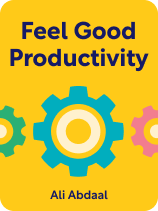

This article is an excerpt from the Shortform book guide to "Feel-Good Productivity" by Ali Abdaal. Shortform has the world's best summaries and analyses of books you should be reading.
Like this article? Sign up for a free trial here.
What’s Feel-Good Productivity by Ali Abdaal about? Does the daily grind have to be a grind?
In Feel-Good Productivity, Ali Abdaal explains why and how emotional well-being will boost your productivity. By taking care of yourself, you can work in a way that’s beneficial to you.
Read below for an overview of Feel-Good Productivity.
Feel-Good Productivity by Ali Abdaal
In Feel-Good Productivity, Ali Abdaal says that most people have the wrong ideas about how to be productive: He argues that getting things done should feel natural, easy, and—most importantly—enjoyable. He provides a comprehensive system for rejecting the “grind” mindset, boosting your emotional well-being, and learning how to work in ways that energize you instead of drain you.
Abdaal is an entrepreneur, YouTuber, and podcaster, as well as a popular productivity expert. Abdaal studied medicine at Cambridge University and worked as a doctor in the UK—though he soon left the medical field, he credits his current understanding of productivity to his struggles as a medical student and junior doctor. His background in medical science also informs Abdaal’s research- and evidence-based approach to the self-help genre.
What’s Feel-Good Productivity?
Abdaal’s model of productivity is based on the idea that work not only can be enjoyable, but it should be enjoyable. When work feels good, it energizes you instead of drains you, meaning you can get a lot more done. Therefore, feel-good productivity not only boosts your emotional well-being, it also benefits the people who rely on you.
Abdaal bases his model of feel-good productivity on the broaden-and-build theory of positive emotions. The broaden-and-build theory states that feeling good isn’t just a brief reward for accomplishing something; those positive emotions directly lead to even greater accomplishments.
When you feel good, you’re more receptive to new information and more likely to think of creative ideas—in other words, feeling good broadens your mind. Good feelings also build a reserve of mental and emotional energy that you can tap as needed.
Abdaal adds that feel-good productivity is in direct opposition to the “grind” that modern culture glamorizes. The popular theory of productivity today is based on discipline and endurance: How much can you force yourself to do? How much stress can you withstand? However, as will become clear throughout this guide, that’s the opposite of how people naturally work.
In this section, we’ll discuss how Abdaal’s model creates a virtuous cycle that will make you happier, more energized, and more productive throughout your life. We’ll also discuss why he says this method works and share a key tip to help you work through this guide effectively.
The Virtuous Cycle of Feel-Good Productivity
Abdaal says that his model of feel-good productivity can be summed up as a virtuous cycle. A virtuous cycle is a system where each step feeds naturally into the next step, leading to better outcomes over time.
The feel-good productivity cycle is as follows:
- Feeling good boosts your energy.
- Energy boosts your productivity.
- Productivity makes you feel even better, and the cycle begins again.
The Science: Why Feel-Good Productivity Works
Abdaal, who trained as a medical doctor, says that feel-good productivity is effective because it harnesses people’s natural biology and neurology. In simple terms, your body and brain instinctively know when you’re working in a healthy way; they reward you for it with good feelings (to encourage you to keep working that way) and increased energy (so you’re able to keep working that way).
Abdaal explains that you feel positive emotions when your brain releases certain hormones, such as dopamine and serotonin. However, these hormones don’t just produce pleasant feelings, they also have a wide variety of effects that will make you more energetic and productive. For instance, the feeling of excitement comes from dopamine; dopamine also boosts your concentration so you can more effectively pursue the thing you’re excited about.
So, Abdaal designed the feel-good productivity model to help you work in ways that cause you to produce more of those attention- and energy-boosting hormones, and your good feelings let you know that you’re doing it correctly.
On the other hand, says Abdaal, the grind mindset taps into negative feelings that trigger the production of stress hormones such as adrenaline and cortisol.
In nature, these stress hormones would help us protect ourselves from danger and withstand pain. As such, they provide powerful short-term motivation, but they have harmful long-term effects. This is because we didn’t evolve to spend our whole lives feeling stressed and pressured, meaning we aren’t designed to be constantly flooded with adrenaline and cortisol.
Tip: Take a Scientific Approach
Abdaal emphasizes that everyone is different, and what makes one person feel good might not help someone else. The important thing is to figure out what works for you. Therefore, he urges you to think of yourself as a scientist as you integrate feel-good productivity into your life. This means experimenting with different ideas and seeing what the results are.
If a suggestion in this guide boosts your happiness and productivity, keep doing it; if not, then let it go. Forcing yourself to do everything Abdaal suggests is just another type of grind, and it’s therefore the opposite of the feel-good productivity mindset.
Tap the Three Sources of Good Feelings
Abdaal begins by explaining the three sources of positive emotions, which he calls energizers. While there are any number of things that can help you feel good—and therefore make you more productive—they all tie back to one or more of these fundamental sources.
In this section, we’ll discuss each of Abdaal’s three sources of well-being: having fun, empowering yourself, and connecting with other people.
Source #1: Fun
Abdaal says people are hardwired to have fun, and fun is a key part of emotional well-being. You most likely know this from experience: As a child you probably spent countless hours running around, making up games, and playing with whatever had your attention at the moment. There wasn’t a career goal or life plan behind any of this; you were simply having fun because that’s what came naturally to you.
Unfortunately, Abdaal adds, many people lose that sense of fun as they grow up. This happens because our culture teaches that adults are supposed to stop playing games and take life seriously. However, you can recapture that youthful feeling of joy and excitement by finding the little games in everything you do.
Source #2: Empowerment
Abdaal’s second source of emotional well-being is empowerment, by which he means having a sense of control over your actions, work, and life. He gives three suggestions about how to empower yourself.
Pretend You’re Already Empowered
Abdaal’s first suggestion is to be bold. Even if you don’t feel like you’re in control, you can still act like you are. Imagine yourself as somebody with great confidence and self-esteem, and pretend to be that person. With time and practice, it will feel less and less like pretending.
In other words: Fake it until you make it.
See How You’ve Already Improved, Then Keep Improving
Abdaal’s second tip for self-empowerment is to constantly assess and improve your abilities. This helps because knowing that you’re good at what you do will give you a sense of power and control. So, if you’re ever feeling self-conscious about your skills at work or elsewhere, take some time to remember how far you’ve come.
For example, if you like to draw, there will be times when you’re not satisfied with something you’ve created—but if you compare that drawing to something you made when you were just starting out, you’ll realize just how skilled an artist you’ve become since then.
Also, further improving your skills will give you a sense of hope. This is because, even if a situation isn’t what you want it to be, you’ll know that you can improve yourself and eventually change that situation. For instance, if you’re passed over for a promotion at work, you’ll know that you can redouble your efforts and get promoted next time.
Take Responsibility for Everything
Abdaal’s third suggestion is to take responsibility for everything you do. Though it seems counterintuitive, accepting the consequences of your decisions and your actions is a major part of feeling like you’re in control of your life. That’s because, when you take accountability, you understand that what you do really matters. On the other hand, if you avoid accountability, then it will feel like your actions have no effect on you—in other words, it will seem like you have no control over your own life.
The author adds that even when you can’t choose your tasks or goals (a common situation in the workplace, for instance) you still have control over your mindset and actions. That means it’s up to you whether you want to complain and do a halfhearted job, or to give each task your all even if it’s not what you want to be doing.
Source #3: Connection
Abdaal’s third and final source of emotional well-being is connecting with other people. Look for people who naturally boost your well-being and your energy, and spend as much time with them as possible. Simply put, you’ll be happier if you have good people around you.
One way to build connections, or strengthen existing ones, is to help people when they need it. This is effective because working together naturally brings people closer, and helping others creates bonds of gratitude and goodwill that often lead to new friendships.
Furthermore, you don’t have to wait until someone asks you for help—small acts of kindness can brighten someone’s day and often make them want to do the same for you. On that note, remember that connections work both ways; accepting kindness from others will strengthen your connections just as surely as helping them will.
Abdaal’s other suggestion for strengthening connections is to communicate more, and more effectively. He adds that, while it’s important to share your positive thoughts—good news, compliments, and so on—if you only share positive thoughts you might come across as shallow or inauthentic. Therefore, it’s equally important to share some of your negative thoughts: your problems, concerns, and (if appropriate) criticisms. Remember, connection isn’t just about getting people to like you, it’s about getting people to understand and accept you.
Overcome the Three Sources of Procrastination
Along with the three sources of emotional well-being, Abdaal discusses three things that harm your emotional well-being and your productivity. He calls them blockers and says that they’re the cause of all procrastination. Therefore, you can stop procrastinating simply by figuring out which of the three is getting in your way and removing it.
In this section, we’ll discuss Abdaal’s three causes of procrastination: confusion, habit, and anxiety.
Procrastination Cause #1: Confusion
Abdaal’s first cause of procrastination, confusion, is the most straightforward. This simply means that you procrastinate when you aren’t sure what to do—or, more often, you aren’t sure how to do it. Thankfully, the solution is equally straightforward: Usually a few simple questions will clear up any confusion so that you can proceed confidently.
First of all, if necessary, ask some clarifying questions about what you’re supposed to do. What exactly is this task? What, specifically, are you trying to accomplish?
With that said, the more common cause of confusion is how to approach that task. Abdaal’s solution is not to simply ask how a task should be done, but rather to ask why you’re doing it. Knowing the larger goal behind a task will often help you figure out the best way to approach it. In other words, the answer to why will lead to the how.
For instance, if your task is to get a sales report ready, it would be helpful to know whether you’re preparing it for someone else in the company—someone who already knows the company’s procedures, expectations, and jargon—or for someone external like a potential investor, who will need some background information. As with everything we discuss in this guide, the principle is equally applicable to personal tasks. Say your current task is to clean your house; are you doing that just to make your home more pleasant for yourself, or because you’re hosting a party and therefore you need the entire house to be spotless?
Finally, Abdaal says that if you don’t clarify when to do something, you’ll put it off until the last minute (if there’s a deadline) or won’t do it at all (if there’s no deadline). For example, if you have a report due at the end of the work week and you don’t give yourself a specific time to do it, you’ll find yourself scrambling to finish that report on Friday. To give another example, if you’re planning to call a family member but don’t set aside time to do so, you’ll find that you never get around to making that call.
Procrastination Cause #2: Habit
Abdaal says that, while confusion is the most straightforward cause of procrastination, habit is the most common. In short, once you get into the habit of doing nothing, you’ll tend to keep doing nothing.
However, habit works both ways; once you start getting things done, you’ll tend to keep getting things done. Therefore, Abdaal’s solution is to start with something small. Pick a task that will be quick and easy, and do it as soon as possible. For example, if you want to start exercising, you might get started by doing a few pushups or going for a short walk.
It may not seem significant, but accomplishing that simple task will start breaking you out of your bad habit of procrastinating.
Procrastination Cause #3: Anxiety
Abdaal says that the third cause of procrastination is anxiety. People tend to put off doing things—even things they want to do—when they’re worried about what the outcome might be. For example, people are often hesitant about starting a new hobby because they’re worried about looking foolish in front of more experienced hobbyists.
Abdaal adds that there’s no way to completely get rid of your anxiety, but there are a few things you can do to help yourself work through it.
The first step is to identify your anxiety: What, specifically, are you afraid is going to happen? To continue the above example, someone who’s new to a hobby might be anxious about other people making fun of their lack of knowledge or skill.
The second step, says Abdaal, is to assess your anxiety. This means asking yourself whether your anxiety is a reasonable response to something that’s probably not that big of a deal. Abdaal suggests considering, if the thing you’re worried about does happen, how bad will it really be? If someone does make fun of that new hobbyist, will it still matter the next day, the next month, or the next year? If something won’t matter in the long run, then it’s not worth worrying about.
Abdaal says that once you’ve finished those two steps, all that remains is to face your anxiety. With a clear idea of what you’re concerned about, and how reasonable that concern really is, you’re as prepared as you can be to get started.
Avoid the Three Kinds of Burnout
Now you’ve read about harnessing your emotional well-being, as well as overcoming the obstacles that cause you to procrastinate. This final section will teach you how to make your productivity sustainable. In simpler terms, this section discusses how to avoid burnout.
Abdaal begins by saying that burnout sets in when work stops feeling good and starts to feel tedious, meaningless, or overwhelming instead. This means that your work is harming your emotional well-being instead of boosting it. Many people misunderstand this fundamental concept; they assume that burnout is just another word for exhaustion, and they can fix it by simply resting for a day or two.
In this final section, we’ll go over the three types of burnout that Abdaal describes, and how to avoid them.
Burnout Type #1: Strain
Abdaal’s first type of burnout happens when you’re simply trying to do too much; even the positive energy you get from feel-good productivity has limits. So, just like exercising too much can cause you to strain a muscle, doing too much can cause you to “strain” your well-being.
You can avoid or recover from this type of burnout by taking a healthier approach to your day-to-day work. This is simple in theory, but it can be difficult in practice, so Abdaal offers some tips.
Burnout Type #2: Drain
Abdaal’s second type of burnout is a counterpart to the first: Whereas strain happens when you work too much, drain happens when you don’t get enough rest after working. Naturally, this can happen because you don’t take enough time for yourself—however, the problem could also be that you’re not resting in a way that’s truly restorative.
Abdaal explains that effective types of rest help you to feel calm and (temporarily) free of any demands on your time or energy. Each person is different, so only you can discover exactly what works for you. For example, some people find playing video games to be restful, while others prefer creative hobbies like writing or drawing, and still others enjoy going out to the bar or playing sports with their friends.
Most importantly, says Abdaal, whatever your preferred methods of rest are, don’t let them turn into more work. The grind mindset will try to creep in and tell you that your hobbies are a waste of time if you’re not making money with them. However, Abdaal points out that when your hobby becomes your “side hustle,” it no longer restores your energy—instead, it places even more demands on you and makes you burn out even more quickly.
Burnout Type #3: Mismatch
Abdaal’s final type of burnout, mismatch, happens when your work doesn’t line up with your interests and principles. If what you’re doing feels meaningless, that’s a clear sign you’re headed for this kind of burnout.
The easiest way to tell whether you’re suffering from mismatch is to think about why you’re working on something; in short, what’s motivating you? If your only motivation is some kind of reward, such as a paycheck, prestige, or someone else’s goodwill, then the task isn’t a good match for you.
On the other hand, if your feelings are helping to drive you—if you’re excited to work on that task, or you’d be willing to do it even without any reward—then your actions are properly aligned with your goals.
Abdaal saves mismatch burnout for last because it’s the most difficult to avoid and to recover from. He says that matching what you do with what you want is a lifelong process that needs frequent self-evaluations and adjustments.

———End of Preview———
Like what you just read? Read the rest of the world's best book summary and analysis of Ali Abdaal's "Feel-Good Productivity" at Shortform.
Here's what you'll find in our full Feel-Good Productivity summary:
- How to stop procrastination at its source and avoid or recover from burnout
- The crucial link between emotional health and productivity
- How to work in ways that feel energizing instead of draining






